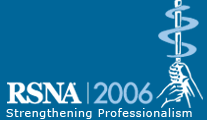
Abstract Archives of the RSNA, 2006
Shlomit Goldberg BA, Abstract Co-Author: Nothing to Disclose
Dominik Fleischmann MD, Abstract Co-Author: Speakers Bureau, Bracco Group
Speakers Bureau, General Electric Company
Speakers Bureau, Siemens AG
Lewis Wexler MD, Abstract Co-Author: Nothing to Disclose
Stanton B. Perry MD, Abstract Co-Author: Nothing to Disclose
Jeffrey A Feinstein MD, Abstract Co-Author: Nothing to Disclose
Frandics Pak Chan MD, PhD, Presenter: Nothing to Disclose
Pulmonary vein stenosis (PVS) is a serious complication after surgical repair of anomalous venous connection. Echocardiography and cardiac catheterization are the primary imaging modalities. We tested the utility of cardiac-gated CT pulmonary venography (CTPV) in the assessment of PVS in young children.
Following IRB approval, CTPV examinations performed in children less than 5 years old between 2003 and 2006 were retrospectively identified. CT protocol was retrospectively ECG-gated, 0.75-1 mm thin section spiral scan of the heart using bolus tracking technique. Pulmonary veins were evaluated for their pattern of connectivity from the lung to the left atrium and for the presence of stenosis. CT findings of PVS were compared with (1) combined findings from catheterization and surgery, and (2) echocardiography.
There were 14 studies performed in children ages 2 days-5 years (mean 1.4 years) for the evaluation of PVS. The average heart rate was 112 bpm (range 73-150 bpm). Pulmonary venous drainage from the right lung (n=14), left lung (n=14) and surgical anastomosis to the left atrium (n=5) were evaluated as separate structures (n=33). Of the 33 structures, 18 had surgical/catheterization data and 21 had echocardiography for comparison. CTPV visualized 100% (33/33) of the investigated structures, while echocardiography visualized 62% (13/21). CTPV agreed with echocardiography in 54% (7/13) and surgery/catheterization in 94% (17/18) of the available comparisons.
CTPV evaluates the pulmonary venous structure more completely than echocardiography. CTPV has a high concordance rate with surgery/catheterization in young children, and may serve as a noninvasive alternative.
Cardiac-gated CT pulmonary venography is a reliable, noninvasive method of detecting pulmonary stenosis in young children.
Goldberg, S,
Fleischmann, D,
Wexler, L,
Perry, S,
Feinstein, J,
Chan, F,
Noninvasive Assessment of Pulmonary Vein Stenosis in Young Children Using Cardiac-gated CT. Radiological Society of North America 2006 Scientific Assembly and Annual Meeting, November 26 - December 1, 2006 ,Chicago IL.
http://archive.rsna.org/2006/4439445.html

